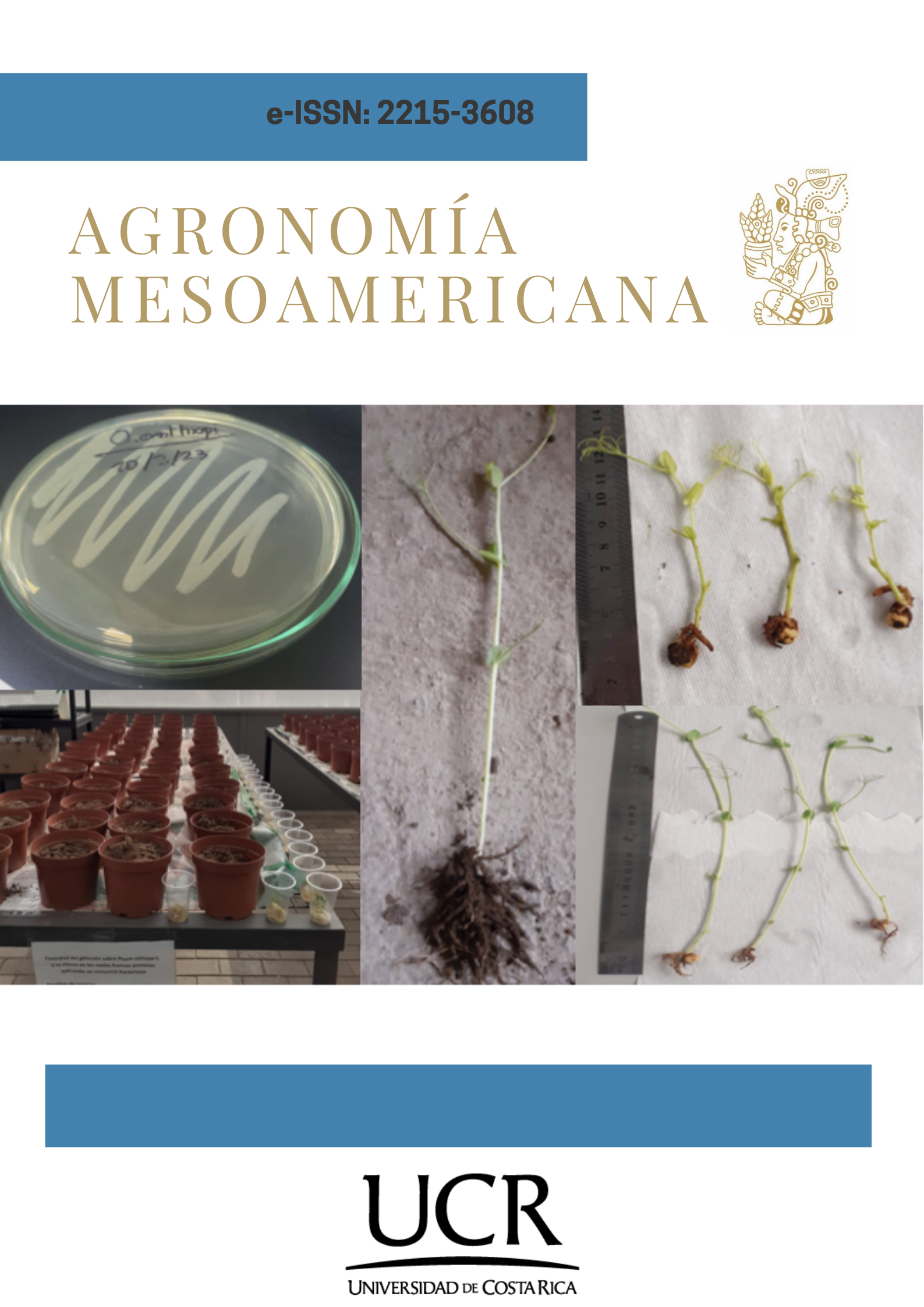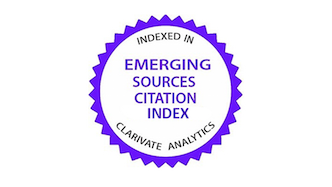Toxicidad del glifosato sobre arveja (Pisum sativum) en suelo franco-arenoso con un consorcio bacteriano
DOI:
https://doi.org/10.15517/am.2025.63041Palabras clave:
biología del suelo, herbicida, microorganismo, Ochrobactrum anthropi, Pseudomonas aeruginosaResumen
Introducción. El glifosato (GLI) es un herbicida común que, cuando es aplicado en exceso, puede afectar tanto a las malezas de hoja ancha. Las bacterias promotoras del crecimiento de plantas pueden favorecer la resistencia y protección de los cultivos agrícolas por efecto del GLI. Objetivo. Evaluar la toxicidad del GLI en la raíz, tallo y raíz + tallo de Pisum sativum (arveja) en suelo franco-arenoso, con la presencia de las bacterias Ochrobactrum anthropi y Pseudomonas aeruginosa de manera individual y en un consorcio bacteriano conformado por ambos microorganismos. Materiales y métodos. El experimento se llevó a cabo en un invernadero en Lima, Perú. Se realizó un diseño completamente aleatorizado con 32 tratamientos, cuyo suelo se mezcló con GLI y fue sometido a análisis edafológicos. Cuatro tratamientos fueron controles, doce contenían suelo con O. anthropi y P. aeruginosa de forma individual y en un consorcio bacteriano, y dieciséis tratamientos contenían además P. sativum. Resultados. P. sativum expuesto a 8,71 mL L-1 y 17,42 mL L-1 de GLI mostró una reducción significativa en el crecimiento, particularmente en la biomasa fresca del tallo y la raíz, pero la aplicación de un consorcio bacteriano revirtió este efecto, lo que mejoró el crecimiento. El GLI alteró el pH y la conductividad eléctrica del suelo, aunque la materia orgánica no cambió. El potasio disponible en el suelo aumentó con GLI, pero las bacterias redujeron este efecto, y el fósforo disponible incrementó en presencia de P. sativum y GLI a 17,42 mL L-1. Conclusiones. El GLI a las concentraciones más altas afectó el crecimiento del tallo y de la raíz de P. sativum, pero la inoculación bacteriana atenuó este efecto y modificó las propiedades del suelo. Esto subraya la relevancia de la interacción entre herbicida, microorganismos y parámetros edafológicos en la agricultura.
Referencias
Abahonza de la Cruz, D. V., Benavides Mejía, O. A., Fajardo Escobar, C. P., & Huertas Delgado, J. L. (2022). Remediación de suelos degradados con glifosato a partir de enmiendas orgánicas a escala laboratorio. En J. L. Huertas Delgado, L. N. Torres Martinez, L. G. Lafaurie Ponce, & J. E. Insuasty Enríquez (Eds.), Las ciencias ambientales y su avance sin fronteras durante la pandemia (pp. 153–167). Editorial Unimar. https://doi.org/10.31948/editorialunimar.171.c222 DOI: https://doi.org/10.31948/editorialunimar.171.c222
Ali, S., Abbas, Z., Rizwan, M., Zaheer, I. E., Yavaş, İ., Ünay, A., Abdel-Daim, M. M., Bin-Jumah, M., Hasanuzzaman, M., & Kalderis, D. (2020). Application of floating aquatic plants in phytoremediation of heavy metals polluted water: a review. Sustainability, 12(5), Article 1927. https://doi.org/10.3390/su12051927 DOI: https://doi.org/10.3390/su12051927
Arispe-Vázquez, J. L., Cadena-Zamudio, D. A., Tamayo-Esquer, L. M., Noriega-Cantú, D. H., Toledo-Aguilar, R., Felipe-Victoriano, M., Barrón-Bravo, O. G., Reveles-Hernández, M., Ramírez-Sánchez, S. E., & Espinoza-Ahumada, C. A. (2023). A review of the current panorama of glyphosate resistance among weeds in Mexico and the rest of the world. Agro Productividad, 16(7), 135–149. https://doi.org/10.32854/agrop.v16i7.2618 DOI: https://doi.org/10.32854/agrop.v16i7.2618
Badii, M. H., & Varela, S. (2015). Insecticidas organofosforados: efectos sobre la salud y el ambiente. CULCYT, Cultura Científica y Tecnológica, 28(5), 5–17. https://erevistas.uacj.mx/ojs/index.php/culcyt/article/view/375
Bhatt, P., Bhatt, K., Sharma, A., Zhang, W., Mishra, S., & Chen, S. (2021). Biotechnological basis of microbial consortia for the removal of pesticides from the environment. Critical Reviews in Biotechnology, 41(3), 317–338. https://doi.org/10.1080/07388551.2020.1853032 DOI: https://doi.org/10.1080/07388551.2020.1853032
Burbano-Orjuela, H. (2016). El suelo y su relación con los servicios ecosistémicos y la seguridad alimentaria. Revista de Ciencias Agrícolas, 33(2), 117–124. https://doi.org/10.22267/rcia.163302.58 DOI: https://doi.org/10.22267/rcia.163302.58
Cantaro Segura, H. B. (2019). Reguladores de crecimiento en el cultivo de arveja (Pisum sativum L.) cv. Rondo en La Molina [Tesis de maestría, Universidad Nacional Agraria La Molina]. Repositorio Institucional de la Universidad Nacional Agraria La Molina. https://repositorio.lamolina.edu.pe/handle/20.500.12996/3893
Carrero, A., Zambrano, A., Hernández, E., Contreras, F., Machado, D., Bianchi, G., & Varela, R. (2015). Comparación de dos métodos de extracción de fósforo disponible en un suelo ácido. Avances en Química, 10(Especial), 29–33. http://erevistas.saber.ula.ve/index.php/avancesenquimica/article/view/6931
Castrejón-Godínez, M. L., Tovar-Sánchez, E., Valencia-Cuevas, L., Rosas-Ramírez, M. E., Rodríguez, A., & Mussali-Galante, P. (2021). Glyphosate pollution treatment and microbial degradation alternatives, a review. Microorganisms, 9(11), Article 2322. https://doi.org/10.3390/microorganisms9112322 DOI: https://doi.org/10.3390/microorganisms9112322
Chávez-Ortiz, P., Tapia-Torres, Y., Larsen, J., & García-Oliva, F. (2022). Glyphosate-based herbicides alter soil carbon and phosphorus dynamics and microbial activity. Applied Soil Ecology, 169, Article 104256. https://doi.org/10.1016/j.apsoil.2021.104256 DOI: https://doi.org/10.1016/j.apsoil.2021.104256
Cheloufi, R., Messaadia, H., & Alayat, H. (2017). Biodegradation of herbicides by Pseudomonas aeruginosa in two soils types of the Bou Namoussa irrigable perimeter (Algerian Extreme Northeast): Effects on mineral nutrition (P2O5 and NO3). Journal of Materials and Environmental Science, 8(7), 2513–2521. https://www.jmaterenvironsci.com/Document/vol8/vol8_N7/270-JMES-2713-Cheloufi.pdf
Dawood, M. G., Abdel-Baky, Y. R., El-Awadi, M. E. S., & Bakhoum, G. S. (2019). Enhancement quality and quantity of faba bean plants grown under sandy soil conditions by nicotinamide and/or humic acid application. Bulletin of the National Research Centre, 43, Article 28. https://doi.org/10.1186/s42269-019-0067-0 DOI: https://doi.org/10.1186/s42269-019-0067-0
Ezaka, E., Akintokun, A. K., Akintokun, P. O., Taiwo, L. B., Uthman, A. C. O., Oyedele, O. A., & Aluko, O. I. (2018). Glyphosate degradation by two plant growth promoting bacteria (PGPB) isolated from rhizosphere of maize. Microbiology Research Journal International, 26(6), 1–11. https://doi.org/10.9734/mrji/2018/v26i630081 DOI: https://doi.org/10.9734/mrji/2018/v26i630081
Fernandes, B., Soares, C., Braga, C., Rebotim, A., Ferreira, R., Ferreira, J., Fidalgo, F., Pereira, R., & Cachada, A. (2020). Ecotoxicological assessment of a glyphosate-based herbicide in cover plants: Medicago sativa L. as a model species. Applied Sciences, 10(15), Article 5098. https://doi.org/10.3390/app10155098 DOI: https://doi.org/10.3390/app10155098
Góngora Echeverría, V. R., García Escalante, R., Rojas Herrera, R., Giácoman Vallejos, G., & Ponce Caballero, C. (2020). Pesticide bioremediation in liquid media using a microbial consortium and bacteria-pure strains isolated from a biomixture used in agricultural areas. Ecotoxicology and Environmental Safety, 200, Article 110734. https://doi.org/10.1016/j.ecoenv.2020.110734 DOI: https://doi.org/10.1016/j.ecoenv.2020.110734
González Ortega, E., & Fuentes Ponce, M. H. (2022). Dinámica del glifosato en el suelo y sus efectos en la microbiota. Revista Internacional de Contaminación Ambiental, 38, 127–144. https://doi.org/10.20937/RICA.54197 DOI: https://doi.org/10.20937/RICA.54197
Grewal, K., Kumar, S., Amin Bhat, M., & Dinesh. (2017). Comparison of chemical extractants for determination of available potassium. International Journal of Chemical Studies, 5(6), 417–423. https://www.chemijournal.com/archives/2017/vol5issue6/PartF/5-5-369-532.pdf
Gustinasari, K., Pandebesie, E. S., Syafei, A. D., & Hermana, J. (2021). Phytotoxicity of glyphosate-based herbicide to Typha angustifolia and Vetiveria zizanioides and its effect on rhizosphere bacteria. Nanotechnology for Environmental Engineering, 6(3), Article 45. https://doi.org/10.1007/s41204-021-00140-1 DOI: https://doi.org/10.1007/s41204-021-00140-1
Gutiérrez, R. E., & Cáceres, C. A. (2018). Correlación entre la conductividad eléctrica medida en el extracto de saturación del suelo y en extractos con cinco relaciones suelo agua. ALFA, 2(6), 144–156. https://doi.org/10.33996/revistaalfa.v2i6.46 DOI: https://doi.org/10.33996/revistaalfa.v2i6.46
Hébert, M.-P., Fugère, V., & Gonzalez, A. (2018). The overlooked impact of rising glyphosate use on phosphorus loading in agricultural watersheds. Frontiers in Ecology and the Environment, 17(1), 48–56. https://doi.org/10.1002/fee.1985 DOI: https://doi.org/10.1002/fee.1985
Heck, K., De Marco, É. G., Duarte, M. W., Salamoni, S. P., & Van Der Sand, S. (2015). Pattern of multiresistant to antimicrobials and heavy metal tolerance in bacteria isolated from sewage sludge samples from a composting process at a recycling plant in southern Brazil. Environmental Monitoring and Assessment, 187(6), Article 328. https://doi.org/10.1007/s10661-015-4575-6 DOI: https://doi.org/10.1007/s10661-015-4575-6
Hou, W. J., Zou, M., Li, B. F., & Yu, Y. C. (2020). Effect of glyphosate on soil physicochemical properties of Eucalyptus plantations. Scientia Silvae Sinicae, 56(8), 20–26. https://doi.org/10.11707/j.1001-7488.20200803
Hove-Jensen, B., Zechel, D. L., & Jochimsen, B. (2014). Utilization of glyphosate as phosphate source: biochemistry and genetics of bacterial carbon-phosphorus lyase. Microbiology and Molecular Biology Reviews, 78(1), 176–197. https://doi.org/10.1128/mmbr.00040-13 DOI: https://doi.org/10.1128/MMBR.00040-13
Izquierdo Bautista, J., & Arévalo Hernández, J. J. (2021). Determinación del carbono orgánico por el método químico y por calcinación. Ingeniería y Región, 26(2), 20–28. https://doi.org/10.25054/22161325.2527 DOI: https://doi.org/10.25054/22161325.2527
Ledoux, M. L., Hettiarachchy, N., Yu, X., Howard, L., & Sun-Ok, L. (2020). Penetration of glyphosate into the food supply and the incidental impact on the honey supply and bees. Food Control, 109, Article 106859. https://doi.org/10.1016/j.foodcont.2019.106859 DOI: https://doi.org/10.1016/j.foodcont.2019.106859
Lizarbe Alache, L. E., Vega Córdova, E. A., & Lizarbe Córdova, J. A. (2020). Adaptación y eficiencia agronómica en el maíz amarillo duro (Zea mays L.) en diferentes localidades de la costa central y norte del Perú. Boletín Redipe, 9(11), 260–271. https://doi.org/10.36260/rbr.v9i11.1129 DOI: https://doi.org/10.36260/rbr.v9i11.1129
Merani, V. H., Millan, G. J., Ferro, D. A., Larrieu, L., Bennardi, D., Polich, N., Juan, L., & Bongiorno, F. M. (2019). Comparación de metodologías de determinación de la conductividad eléctrica y concentración iónica en suelos de la provincia de Buenos Aires. Ciencias Agronómicas, 19, Article e003. https://doi.org/10.35305/agro34.277 DOI: https://doi.org/10.35305/agro34.277
Mertens, M., Höss, S., Neumann, G., Afzal, J., & Reichenbecher, W. (2018). Glyphosate, a chelating agent-relevant for ecological risk assessment? Environmental Science and Pollution Research, 25(6), 5298–5317. https://doi.org/10.1007/s11356-017-1080-1 DOI: https://doi.org/10.1007/s11356-017-1080-1
Ministerio del Ambiente. (2014). Guía para el muestreo de suelos y la guía para la elaboración de planes de descontaminación de suelos (Resolución Ministerial N° 085-2014-MINAM). https://www.minam.gob.pe/disposiciones/resolucion-ministerial-n-085-2014-minam/
Mohy-Ud-Din, W., Chen, F., Bashir, S., Akhtar, M. J., Asghar, H. N., Farooqi, Z. U. R., Zulfiqar, U., Haider, F. U., Afzal, A., & Alqahtani, M. D. (2023). Unlocking the potential of glyphosate-resistant bacterial strains in biodegradation and maize growth. Frontiers in Microbiology, 14, Article 1285566. https://doi.org/10.3389/fmicb.2023.1285566 DOI: https://doi.org/10.3389/fmicb.2023.1285566
Morrás, H., Behrends Kraemer, F., Sainz, D., Fernández, P., & Chagas, C. (2022). Soil structure and glyphosate fate under no-till management in the Pampa region. II. Glyphosate and AMPA persistence and spatial distribution in the long-term. A conceptual model. Soil and Tillage Research, 223, Article 105471. https://doi.org/10.1016/j.still.2022.105471 DOI: https://doi.org/10.1016/j.still.2022.105471
Obour, A. K., Stahlman, P. W., & Holman, J. D. (2016). Soil chemical properties as influenced by long-term glyphosate-resistant corn and soybean production in the central Great Plains, USA. Geoderma, 277, 1–9. https://doi.org/10.1016/j.geoderma.2016.04.029 DOI: https://doi.org/10.1016/j.geoderma.2016.04.029
Pedemonte Castro, F. E. (2017). Problemática del uso de glifosato [Tesis de grado, Universidad Nacional Agraria La Molina]. Repositorio Institucional de la Universidad Nacional Agraria La Molina. https://repositorio.lamolina.edu.pe/handle/20.500.12996/3011
Pronk, G. J., Heister, K., Vogel, C., Babin, D., Bachmann, J., Ding, G.-C., Ditterich, F., Gerzabek, M. H., Giebler, J., Hemkemeyer, M., Kandeler, E., Kunhi Mouvenchery, Y., Miltner, A., Poll, C., Schaumann, G. E., Smalla, K., Steinbach, A., Tanuwidjaja, I., Tebbe, C. C., … Kögel-Knabner, I. (2017). Interaction of minerals, organic matter, and microorganisms during biogeochemical interface formation as shown by a series of artificial soil experiments. Biology and Fertility of Soils, 53(1), 9–22. https://doi.org/10.1007/s00374-016-1161-1 DOI: https://doi.org/10.1007/s00374-016-1161-1
Romano-Armada, N., Amoroso, M. J., & Rajal, V. B. (2019). Construction of a combined soil quality indicator to assess the effect of glyphosate application. Science of the Total Environment, 682, 639–649. https://doi.org/10.1016/j.scitotenv.2019.05.079 DOI: https://doi.org/10.1016/j.scitotenv.2019.05.079
Rossi, F., Carles, L., Donnadieu, F., Batisson, I., & Artigas, J. (2021). Glyphosate-degrading behavior of five bacterial strains isolated from stream biofilms. Journal of Hazardous Materials, 420, Article 126651. https://doi.org/10.1016/j.jhazmat.2021.126651 DOI: https://doi.org/10.1016/j.jhazmat.2021.126651
Shahid, M., Ahmed, B., Zaidi, A., & Khan, M. S. (2018). Toxicity of fungicides to Pisum sativum: A study of oxidative damage, growth suppression, cellular death and morpho-anatomical changes. RSC Advances, 67, 38483–38498. https://doi.org/10.1039/c8ra03923b DOI: https://doi.org/10.1039/C8RA03923B
Silva, F. M. L., Duke, S. O., Dayan, F. E., & Velini, E. D. (2016). Low doses of glyphosate change the responses of soyabean to subsequent glyphosate treatments. Weed Research, 56(2), 124–136. https://doi.org/10.1111/wre.12189 DOI: https://doi.org/10.1111/wre.12189
Singh, S., Kumar, V., Gill, J. P. K., Datta, S., Singh, S., Dhaka, V., Kapoor, D., Wani, A. B., Dhanjal, D. S., Kumar, M., Harikumar, S. L., & Singh, J. (2020). Herbicide glyphosate: Toxicity and microbial degradation. International Journal of Environmental Research and Public Health, 17(20), Article 7519. https://doi.org/10.3390/ijerph17207519 DOI: https://doi.org/10.3390/ijerph17207519
Singh, S., Kumar, V., Sidhu, G. K., Datta, S., Singh Dhanjal, D., Koul, B., Singh Janeja, H., & Singh, J. (2019). Plant growth promoting rhizobacteria from heavy metal contaminated soil promote growth attributes of Pisum sativum L. Biocatalysis and Agricultural Biotechnology, 17, 665–671. https://doi.org/10.1016/j.bcab.2019.01.035 DOI: https://doi.org/10.1016/j.bcab.2019.01.035
Smedbol, É., Lucotte, M., Maccario, S., Gomes, M. P., Paquet, S., Moingt, M., Mercier, L. L. C., Sobarzo, M. R. P., & Blouin, M.-A. (2019). Glyphosate and Aminomethylphosphonic Acid Content in Glyphosate-Resistant Soybean Leaves, Stems, and Roots and Associated Phytotoxicity Following a Single Glyphosate-Based Herbicide Application. Journal of Agricultural and Food Chemistry, 67(22), 6133–6142. https://doi.org/10.1021/acs.jafc.9b00949 DOI: https://doi.org/10.1021/acs.jafc.9b00949
Suwardji, S., & Sudantha, I. M. (2021). The fate of glyphosate in soil and water: A review. Jurnal Penelitian Pendidikan IPA, 7(Special Issue), 389–399. https://doi.org/10.29303/jppipa.v7iSpecialIssue.971 DOI: https://doi.org/10.29303/jppipa.v7iSpecialIssue.971
Tofiño Rivera, A. P., Carbono Murgas, R. E., Melo Ríos, A. E., & Merini, L. J. (2020). Efecto del glifosato sobre la microbiota, calidad del suelo y cultivo de frijol biofortificado en el departamento del Cesar, Colombia. Revista Argentina de Microbiología, 52(1), 61–71. https://doi.org/10.1016/j.ram.2019.01.006 DOI: https://doi.org/10.1016/j.ram.2019.01.006
Villarreal, R. (2018). Variación temporal de las propiedades físicas del suelo y su impacto en la dinámica del glifosato en suelos bajo siembra directa y labranza convencional [Tesis de doctorado, Universidad Nacional de La Plata]. Repositorio SEDICI de la Universidad Nacional de La Plata. https://sedici.unlp.edu.ar/handle/10915/72021
Xu, X., Luo, Q., Zhang, N., Wu, Y., Wei, Q., Huang, Z., & Dong, C. (2024). Sandy loam soil maintains better physicochemical parameters and more abundant beneficial microbiomes than clay soil in Stevia rebaudiana cultivation. PeerJ, 12, Article e18010. https://doi.org/10.7717/peerj.18010 DOI: https://doi.org/10.7717/peerj.18010

Archivos adicionales
Publicado
Licencia

Esta obra está bajo una licencia internacional Creative Commons Atribución-NoComercial-SinDerivadas 4.0.
1. Política propuesta para revistas de acceso abierto
Los autores/as que publiquen en esta revista aceptan las siguientes condiciones:
- Los autores/as conservan los derechos morales de autor y ceden a la revista el derecho de la primera publicación, con el trabajo registrado con la licencia de atribución, no comercial y sin obra derivada de Creative Commons, que permite a terceros utilizar lo publicado siempre que mencionen la autoría del trabajo y a la primera publicación en esta revista, no se puede hacer uso de la obra con propósitos comerciales y no se puede utilizar las publicaciones para remezclar, transformar o crear otra obra.
- Los autores/as pueden realizar otros acuerdos contractuales independientes y adicionales para la distribución no exclusiva de la versión del artículo publicado en esta revista (p. ej., incluirlo en un repositorio institucional o publicarlo en un libro) siempre que indiquen claramente que el trabajo se publicó por primera vez en esta revista.
- Se permite y recomienda a los autores/as a publicar su trabajo en Internet (por ejemplo en páginas institucionales o personales) antes y durante el proceso de revisión y publicación, ya que puede conducir a intercambios productivos y a una mayor y más rápida difusión del trabajo publicado (vea The Effect of Open Access).





























